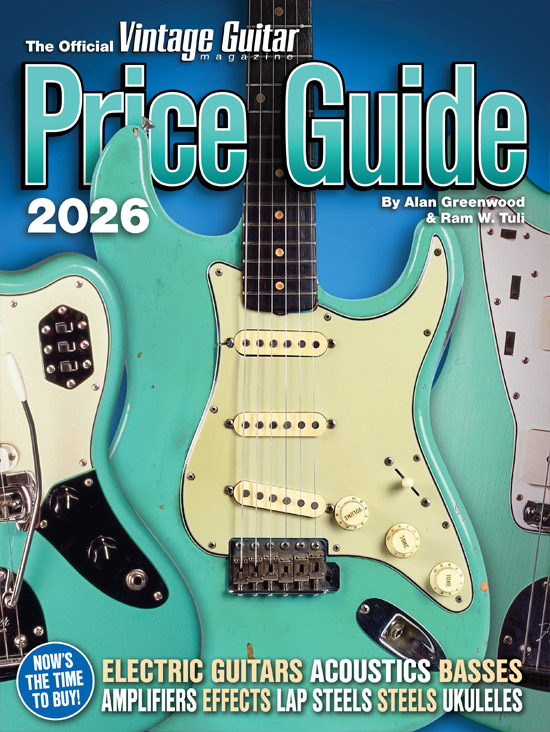When she was seven years old, sibling rivalry spurred Blu DeTiger to get a bass so she could play along with her brother on his new drum kit. After honing her skills for a few years at School of Rock, taking lessons, and playing in high-school bands, she also became a DJ on the New York electronic dance music (EDM) scene, setting herself apart by plugging in her bass to jam along.
In 2017, DeTiger began releasing original music, using social media to spread the word about her funky, bass-driven songs that fit a wave of disco-influenced pop. Emblematic of how the business works in the 21st century, her following (including 1.4 million on TikTok) garnered attention from Fender, which recently launched a signature Jazz Bass that sets a precedent while bringing an array of cool elements (see this month’s “Approved Gear”).
You got into playing because your older brother, Rex, started playing drums when he was 10. How did you land on bass?
I wanted to try playing something and there are always a lot of people playing guitar, so I wanted to be different. I tried bass and fell in love with it.
What was your first?
A short-scale Gretsch, which was really cool. From there, I got a Fender Mustang, then a reissue Precision and a Rickenbacker. I did the rounds before I landed on the Jazz Bass as my go-to.
What sort of music were you into when you started?
Classic rock like Zeppelin, the Beatles, and Rolling Stones. From there I got into Bowie. Growing up in New York, I was always around cool music and that energy.
Did bass come easy to you?
It did not (laughs). I wasn’t naturally gifted; I had to really put in the work the first few years. Being so young and the bass being a giant, heavy instrument, the physicality of it took a while to get down. My hands were small and I had to build muscle memory. That took a while, as did training my ear.
What led to your playing funk?
I started getting into that music; I did Victor Wooten’s bass camp at Berkeley, and I did Grammy Camp. By then, I was fully focused on getting better. That’s when I started learning to slap.
Were there certain slap parts that you really dug into?
“Thank You (Falettinme Be Mice Elf Agin)” was a big one, and “Hair” – I was in awe of all of Larry Graham’s stuff. I remember thinking, “That’s the coolest sound a bass can make!” “Glide,” by a band called Pleasure, has an insane bass line.
In high school, you started getting gigs as a DJ.
Yeah, on the cusp of the EDM craze, one of Rex’s friends was throwing a bunch of parties in New York and the guy told me, “You have to meet my friend. He’s teaching people how to DJ. It’s gonna be a big thing and you should learn.” I thought, “You know what? That sounds really sick.” I grew up hearing house music and stuff my parents played, and my dad had turntables at home. So, I got into it and started getting gigs. I’d bring my bass so I could play over songs.
When did you start writing?
Once I was in band settings. I had a band in high school and we’d write songs together in the room. I didn’t start writing my own until I was 18 or 19, when I was recording and singing. I never really got into singing, but I realized that if I wanted to put out my own music, I’d need to sing.
How did you decide on the neck shape for your new signature Jazz Bass?
I did a lot of research and had help from Jerry Barnes, who plays for Nile Rogers and Chic. He has a huge collection of vintage basses – different styles including a lot of Fenders and other brands. I went to his studio and tried a bunch until I was like, “Okay, this neck shape is what I like the best.” The signature model is more based on a Custom Shop Jazz we did a few years ago with the same finish.
What inspired the finish?
Aesthetically, I wanted something that fit my brand and my vibe. The blue sparkle came from wanting something that was different and unique. I like instruments that can stand alone as a piece of art – things that are beautiful to look at. And because performing is my favorite thing in the world, I like instruments that stand out onstage. My name being Blu, I had to have blue (chuckles), and we did a bunch of color swatches for the sparkles to make it right; the first iteration was too sparkly, so we went back.
What were you going for tone-wise?
I love the Bernard Edwards late-’70s funk sound. We discussed ways to get that, and they thought it could be cool to try the humbucker and active preamp, to keep it from losing midrange or low-end because of the chambering. When they sent the first prototype, I loved it. We made a few tweaks to the bridge and some other things, aesthetically, and with the second prototype I was like, “This is perfect! It’s getting every sound I want.”
This article originally appeared in VG’s December 2024 issue. All copyrights are by the author and Vintage Guitar magazine. Unauthorized replication or use is strictly prohibited.




